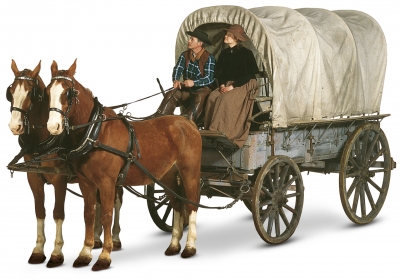
Rumours began to reach the eastern states of the great rich lands of the West. Stories of great rivers, plentiful supplies of food and gold made families decide to risk everything. They sold their homes and packed everything into a small covered wagon.
Because of the risk from Indians and robbers they travelled in large numbers called wagon trains.
Wagon-train transportation moved westward with the advancing frontier. The 19th century saw the development of such famous roads as the Santa Fe Trail, the Oregon Trail, the Smoky Hill Trail, and the Southern Overland Mail route. It was, however, in transit westward over the Oregon-California Trail that the wagon trains attained their most highly organized and institutionalized character. Meeting in early spring at a rendezvous town, perhaps near the Missouri River, the groups would form companies, elect officers, employ guides, and collect essential supplies while awaiting favourable weather, usually in May. Those riding in the wagons were directed and protected by a few on horseback. Once organized and on their way, wagon-train companies tended to follow a fairly fixed daily routine, from 4 AM rising, to 7 AM leaving, 4 PM encampment, cooking and tending to chores while the animals grazed, and simple recreation before early retirement. The companies had to be prepared for such challenges as crossing rivers and mountains and meeting hostile Indians.
Wagon-train migrations are more widely known and written about than wagon freighting, which also played an essential role in an expanding America. Teamsters, best known as bullwhackers or muleskinners, conducted commercial operations on a more or less fixed two-way schedule until replaced by the railroad and the truck.
Credit : Britannica
Picture Credit : Google




